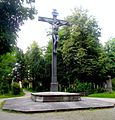Johann Halbig
Johann Halbig | |
|---|---|
 Johann von Halbig | |
| Born | Johann Halbig 13 July 1814 |
| Died | 29 August 1882 (aged 68) |
| Nationality | German, Bavarian |
| Known for | Sculpting |
| Movement | Classicism |
Johann Halbig (also Johann von Halbig) (13 July 1814 – 29 August 1882) was a German sculptor of the Classicism school.
Biography[edit]
He was born at Donnersdorf in Lower Franconia and was educated at the Polytechnical School and at the Academy of Fine Arts in Munich. After the early death of his teacher and employer Ernst Mayer he became his successor as professor of sculpture at the Polytechnic School in Munich, where most of his works can be found. His work is characterized by its decorative quality. Johann Halbig died in Munich and was buried in the Alter Südfriedhof.
Works[edit]
His most notable production was the colossal group of a quadriga and lions on the triumphal arch (1847). He also carved the lions of the Pinakothek and statues of Roma and Minerva in the palace gardens. He created 18 colossal statues representing the leading German provinces for the Befreiungshalle at Kelheim; 60 busts for the Pinakothek (Munich); a statue of King Maximilian II for Lindau (1854); a monument of Count Platen at Ansbach (1858); the monument of Marshal Cachahiba d'Argolo in Bahía, Brazil; a statue of King Ludwig I of Bavaria for Kelheim. Among his later works are a statue of Fraunhofer in Munich (1866); an equestrian statue of King William I of Württemberg for Cannstatt (1876); the "Emancipation" group of sculpture in New York (1867–1868); and the "Passion" group at Oberammergau (1875).
Gallery[edit]
-
Hall of Liberty Kelheim
-
Bust of Halbig's teacher Ernst Mayer
-
Lion in Munich
-
Bernhard Erasmus von Deroy, Royal Bavarian General of Infantry
-
Halibig's lion at Lindau (Bodensee)
-
Budapest: statue of Archduke Joseph, Palatine of Hungary
-
Crucifixion in bronze for centrum of Alter Südfriedhof (1850)
-
Colossal crucifixiongroup (12 m high) for Oberammergau commissioned by Ludwig II
Notes[edit]
This article includes a list of references, related reading, or external links, but its sources remain unclear because it lacks inline citations. (May 2013) |
References[edit]
 This article incorporates text from a publication now in the public domain: Gilman, D. C.; Peck, H. T.; Colby, F. M., eds. (1905). "Halbig, Johann". New International Encyclopedia (1st ed.). New York: Dodd, Mead.
This article incorporates text from a publication now in the public domain: Gilman, D. C.; Peck, H. T.; Colby, F. M., eds. (1905). "Halbig, Johann". New International Encyclopedia (1st ed.). New York: Dodd, Mead.
Further reading[edit]
- Hyacinth Holland (1904), "Halbig, Johann", Allgemeine Deutsche Biographie (in German), vol. 49, Leipzig: Duncker & Humblot, pp. 708–785
- Joseph Alois Kuhn (Anonym): Professor Johann Halbig und seine Werke, ein Beitrag zur modernen Kunstgeschichte. Knorr & Hirth, München, 1879. Digitalisat MDZ
- Longin Mößlein: Vom armen Bauernbuben zum geadelten Bildhauer in Schönere Heimat ISSN 0177-4492, Heft 2/2007 des Bayer. Landesvereins für Heimatpflege e.V.
External links[edit]
- . Encyclopedia Americana. 1920.
- . The American Cyclopædia. 1879.








